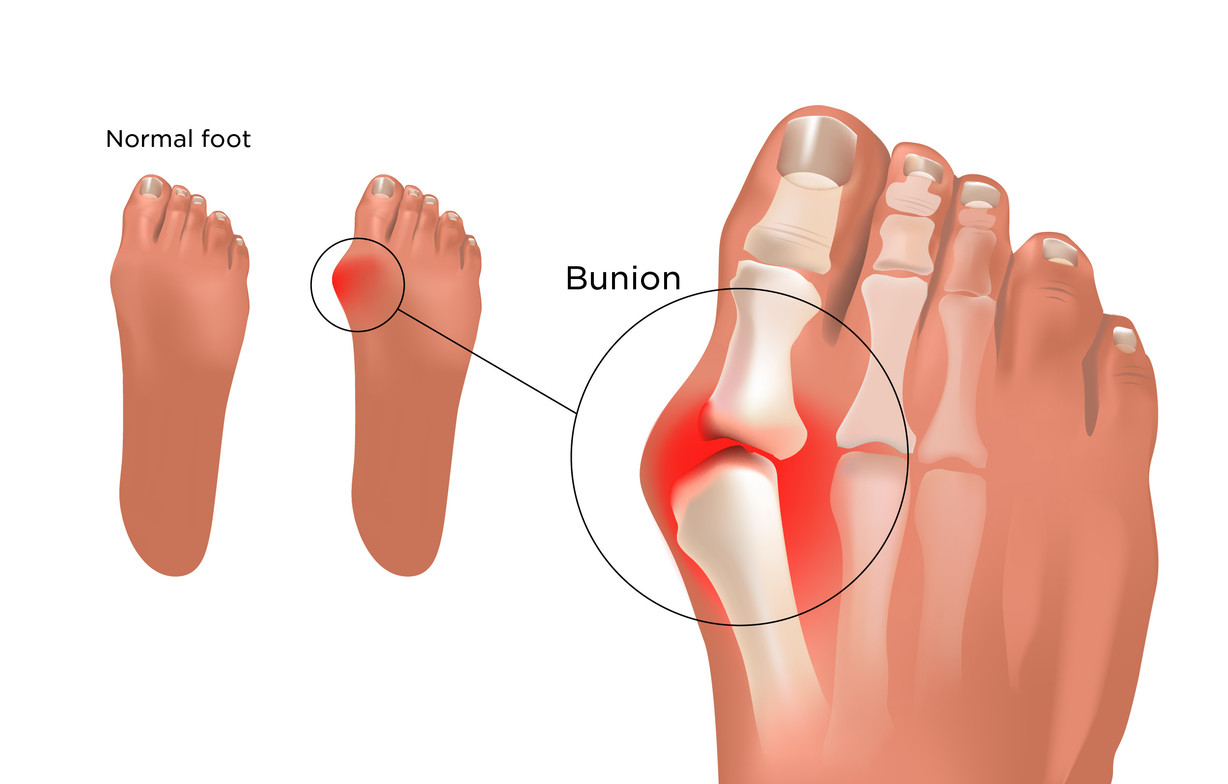
Bunions, also called Hallux Valgus, are one of the most common but misunderstood lower extremity conditions. Foot width and length often increase with age in addition a change in shape can lead to misshapen joints resulting in pressure changes in the skin leading to bunions. A bunion is a bony deformity of the joint at the base of the big toe. The main sign is the big toe pointing towards the other toes on the same foot causing a swollen bumpy lump on the medial aspect of the foot. This causes a painful callus to form which could potentially develop into a sore. This is a condition that progressively gets worse unless addressed or overly painful; however, most cases don't become symptomatic until later in life.
Symptoms include:
- a swollen, bony bump on the outside edge of your foot
- pain and swelling over your big toe joint that's made worse by pressure from wearing shoes
- hard, callused, and red skin is caused by your big toe and second toe overlapping; it is sore skin over the top of the bunion
One of the biggest misconceptions about bunions is that they are genetic and there is nothing you can do about them. There is some genetic factor that puts you at higher risk of anatomical misalignment but much research has been done to prove that you can not only improve pain and range of motions but improve clinical outcomes and completely eliminate pain associated with bunions or hallux valgus.
While bunions may have a genetic basis, certain types of footwear can exacerbate their formation. Tight shoes with a narrow toe box, especially high heels, force the toes into an unnatural position, which can accelerate the development of bunions. This is especially true for individuals already genetically predisposed to the condition.
Your lifestyle can either alleviate or aggravate bunions. For instance, regular foot exercises can strengthen the muscles and improve flexibility, reducing the likelihood of bunions. Additionally, maintaining a healthy weight can relieve the pressure on your feet, which decreases your risk. Exercises that focus on toe mobility can be beneficial.
The most important muscle regarding correcting or fixing bunions is the flexor hallucis longus (FHL). It is a muscle in the calf that flexes the big toe. It's also responsible for other foot and ankle movements but it is especially important that the patient focus on increasing pressure generated beneath the hallux while leaning forward and pushing back. According to an article by Tom Michaud, DC, “Strength in the flexor hallucis longus is the single best predictor of falls in the elderly. In fact, for every 1% increase of body weight generated beneath the hallux, the risk of falling decreases by 7%. In other words, if a 100-pound female produces just 2 extra pounds of force beneath the big toe, her risk of falling decreases 14%. Note that the big toe alone can exert a downward force equaling 52% of body weight, and increasing force output by 1% is easy to achieve.”
We need to move and move well. One of the most common causes is that we do not take our foot health seriously or think about training our feet like we would our chest or biceps. So over time, we use these soft cushy shoes, and we do not adequately strengthen them and they slowly weaken and lose range of motion. This is part of why bunions are not painful or affect athletes until they become sedentary and foot become weaker.
If you notice in newborns and toddlers the toes are the widest part of the foot. As we age we start wearing tight shoes with soft padding, large heels, and moving less often than we should. What this does is compress all of the muscles, nerves, and joints moving together as one instead of independently as they should. There are 26 bones, 30 joint articulations, and more than 100 muscles, tendons, and ligaments IN EACH FOOT.
Why is this important? Think about if you tried to do a pushup with your fingers pressed together or even on top of each other OR if you spread out your fingers and hand and did a pushup. Of course, the ladder is easier but more importantly this is how your feet should operate.
If you or a loved one have been dealing with bunions or foot pain and are curious about what the path to being and staying pain-free is, book a FREE Discovery Visit with us to see how we can help. We'd love to talk more about how Strength & Spine can help you!
.jpg)
.jpg)
